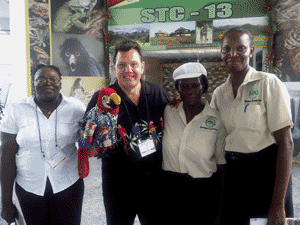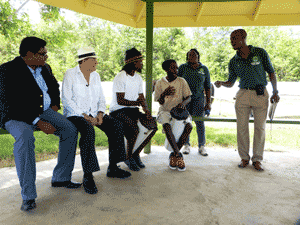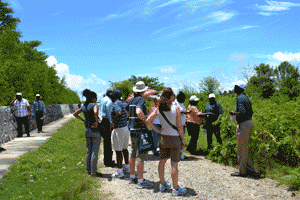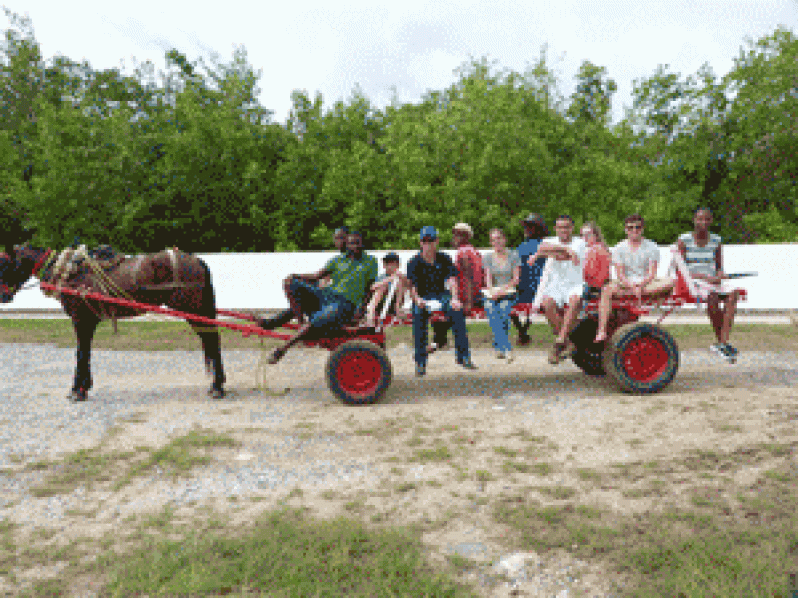 One such success story is Guyana’s first community-owned and managed mangrove reserve which stretches across five communities on the country’s northern coast, from Golden Grove to Belfield.
One such success story is Guyana’s first community-owned and managed mangrove reserve which stretches across five communities on the country’s northern coast, from Golden Grove to Belfield. Traditionally, coastal mangrove forests are a critical part of sea defence, as they prevent erosion and degradation of the country’s vulnerable coastline which is seven feet below sea level, and constantly threatened by recent sea-level rise and increased wave energy.
The Guyana Mangrove Restoration Project (GMRP), which is funded by the Government of Guyana and the European Union, has several components, which include public awareness, research, replanting, and community development.
After a diverse public awareness campaign, citizens residing within and near mangrove forests became aware that protecting and managing mangrove forests is not just a way of securing their future, but also has potential for creating alternative livelihoods at the same time.
Branding One of the GMRP’s first initiatives was to create a mangrove reserve brand that communities were permitted to use on their home-grown and manufactured products, once they were protecting mangrove forests in a tangible way.
One of the GMRP’s first initiatives was to create a mangrove reserve brand that communities were permitted to use on their home-grown and manufactured products, once they were protecting mangrove forests in a tangible way.
These products were launched at a Farmers’ Market in October 2011, which was sponsored by telecommunications giant, Digicel, and crucial to launching the group on their impressive trajectory. The producers, who are mainly women, now have a range of products to their credit, including golden mangrove honey; handmade beeswax candles; cassava bread; coconut biscuits; dried herbs and pepper; and other preserves such as lime, tamarind and mango achar, and peppersauce.
Community development was further realised in the establishment of the Mangrove Visitor Centre housed in the historic 160-year-old former sugar estate house at Cove and John, where the home-grown products at reference are retailed.
Members of the five communities were also trained as tour guides. This subsequently gave birth to the Mangrove Reserve Tour, which allows tourists to learn about mangrove conservation while enjoying a half-day tour of several East Coast villages, and experiencing a way of life that makes us uniquely Guyanese. The tour encompasses a thriving mangrove forest, a wetland teeming with fish and birdlife, drumming and folk singing, and learning about the traditional uses of medicinal plants in the company of our charming village people.
To step back from this picture is to see the increased potential for these coastal villagers to earn a living as tour guides, horse-cart drivers, cane juice vendors, musicians, beekeepers and agri-products producers.
Starting point The Golden Grove/Belfield Mangrove Reserve, 20 minutes from Georgetown, has become a hive of activity, and is the starting point for the tours operating seven days a week, from 7am to 7pm.
The Golden Grove/Belfield Mangrove Reserve, 20 minutes from Georgetown, has become a hive of activity, and is the starting point for the tours operating seven days a week, from 7am to 7pm.
Guyana is known for its rambling wooden structures, with graceful and distinctive Demerara shutters; and that’s the picture you get as you arrive at the sprawling three-storey plantation house at the Village of Cove and John dominating five acres of land covered with towering mango trees in the midst of a verdant herbal garden.
The house reflects an early grandeur of hewn greenheart beams, pine floors and antique cast-iron pillars. Supporting the building’s front gallery are pillars made of bricks brought to Guyana as ballast for sailing ships in the colonial days.
Beautiful banners telling the mangrove story in detail, and an intricate hand-painted mural of the coastline depicting the coastal forests and rich birdlife are part of the permanent display.
From the breezy Visitor Centre, the tour moves by horse-cart, a service provided by members of the Nabacilis community, to Victoria Village. This is the first village bought by former slaves following Emancipation in 1888, and one can pause at the original hut where freed slaves, who opted to continue estate work, collected their weekly pay packages. It’s now a busy village shop, and vendors outside offer fresh coconut water and the juiciest pineapples.
The tour turns briefly towards the sea, where you catch sight of one of the many kokers (a Dutch word meaning “sluice”) that dot the Guyana landscape. Shortly after, you encounter the beautiful temples of the local ashram where Hindu followers come to worship, and which are thronged by visitors from all over Guyana during the celebration of Diwali, which means ‘Festival of Lights’.
You are now in the heart of the Mangrove Reserve, where, as the horse-cart proceeds along a trail parallel to the seawall, can be found all the mangrove species — black, white, red and buttonwood — within the first 100ft stretch.
In this area, hundreds of fully-grown mangrove trees, many of them over 30 feet tall and 25 years old, live in a dense forest that developed, completely on its own, on the swampy foreshore, and now serves as a barrier to the Atlantic tides in the area.
Teeming with wildlife On the other side of the trail is a wide wetland area teeming with scarlet ibis, snowy egrets and pelicans which has become a popular bird-watching stop. A unique part of the wetland is a shallow fish pond containing tilapia, hassar, patwa, and sunfish that is ideal for recreational fishing. If you’re in luck, you will see local fishermen beating the water to chase the fish into their nets, or throwing their cast-nets to haul up a good catch.
On the other side of the trail is a wide wetland area teeming with scarlet ibis, snowy egrets and pelicans which has become a popular bird-watching stop. A unique part of the wetland is a shallow fish pond containing tilapia, hassar, patwa, and sunfish that is ideal for recreational fishing. If you’re in luck, you will see local fishermen beating the water to chase the fish into their nets, or throwing their cast-nets to haul up a good catch.
On the trail, our guides point out the array of medicinal plants used by Guyanese for generations. Growing wild along the path is the legendary “black sage”, a brew from the leaves of which helps combat hypertension and diabetes; the rigid stem of the plant, meanwhile, makes an ideal substitute for the toothbrush.
There is also the “sweet sage”, used to treat colds; the “belly ache bush” that helps combat gum disease; and the ever-popular “tulsi”, a brew from which plant works wonders at relieving flatulence. The leaves of the “noni” plant are used to alleviate pain, and its fruit is reputed to help build up the immune system. There is also a plant, the “carrion crow bush”, the brew of which, according to folklore, is good for terminating pregnancy. Not forgetting the “briar pimpla”, which is used to make garlands which are hung on doorways to keep away “Ol Higue” which suck the blood of old and young!
In the middle of the wetland is a small island of lush black mangrove where bee keepers operate. The nectar from the blossom of the black mangrove produces delectable golden-coloured honey; you can purchase some at the end of the tour from Victoria bee-keepers, Carlotta and Colin deJesus.
As the tour wends its way back to the visitors’ benab near the side of the lake, you are greeted by drummers from Victoria Village who entice you to join in their energetic rendition of the most popular folk songs of the area.
Returning to the Visitor Centre, you can stop at Ingrid’s roadside stand for some local snacks and Guyana’s legendary Demerara Gold, freshly-ground cane juice.
If you’re looking for a short, intensive look at our natural world, and our Guyanese culture, this three-hour tour is the ticket.




.jpg)










